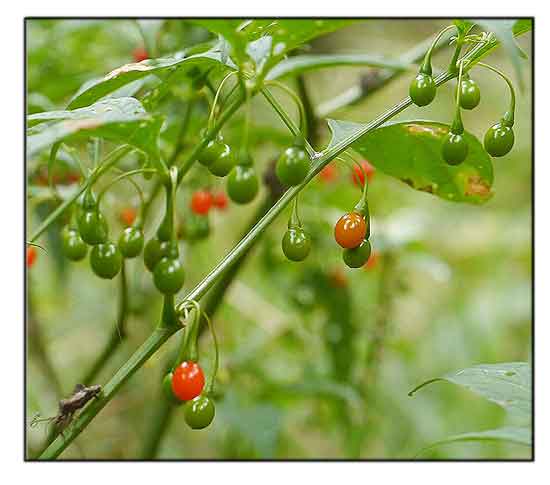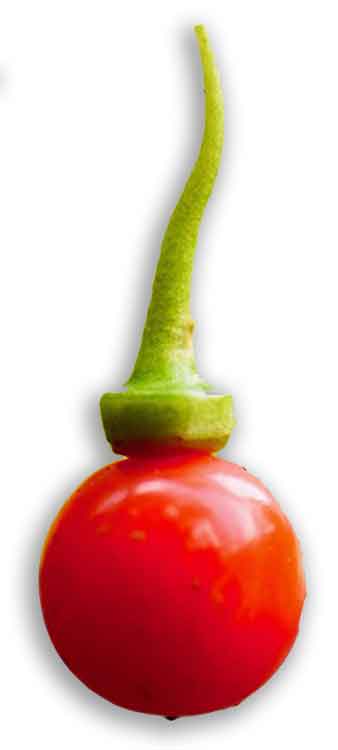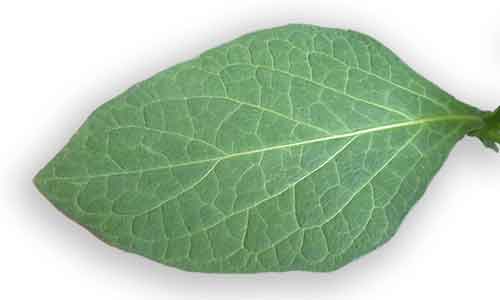 Gen info Gen info
- Tubocapsicum is a genus of flowering plants in the family Solanaceae. It contains two species: one widespread species, Tubocapsicum anomalum (Franch. & Sav.) and a poorly known second species, T. boninense (Makino) Kitamura. (17)
Botany
• Herbs perennial, glabrescent, to 1.5 m tall. Stems terete at base, drying ridged, branching dichotomously. Petiole 1-3 cm; leaf blade ovate, elliptic, or ovate-lanceolate, 5-18 × 3-10 cm, papery, base obtuse, margin subentire, apex acuminate or obtuse; veins arcuate. Inflorescences solitary or up to 12-flowered clusters. Pedicel 1-2 cm, nodding, slightly thicker distally. Calyx cup-shaped, 2-2.5 × 3 mm, truncate. Corolla bright yellow, short campanulate, 5-8 × 6-8 mm; lobes ovate-deltate, recurved, 2-3.5 mm, minutely ciliolate. Filaments ca. 0.5 mm; anthers ca. 1.8 mm. Style 2.5-3 mm. Fruiting calyx not enlarged. Berry shiny, scarlet, 0.8-1.2 cm. Seeds pale yellow, discoid, 1-1.5 mm across. (Flora of China)
Distribution
- Native to the Philippines.
- In Benguet, in mossy forests,1800 to 2200 m, and along streams in shaded raivines, at low and medium altitudes.
- Also native to Assam, Borneo, China South-Central, China Southeast, Japan, Korea, Nansei-shoto, Taiwan, Thailand, Vietnam. (1)
 Constituents Constituents
- Chromatographic separations of aerial parts isolated 8 previously undescribed withanolides (1-8) and 2 artificial withanolides (9-10), in addition to 15 known compounds (11-25). (see study below) (3)
- Study of aerial parts isolated 10 new withanolides (1-10) and three artifical withanolides (11-12), along with five known analogues (14-18). They included seven acnistin-type (1-4, 11, 14 and 15), three withajardin-type (5-7), and eight normal-type (8-10, 12, 13 and 16-18) withanolides. (see study below) (6)
- Study of stems, roots, and leaves isolated 15
new withanolides (1-8, 11-17) and two known withanolides, withanolide D (9) and 17α-hydroxywithanolide D (10). (see study below) (7)
- Study of fruit isolated two new C28 steroidal glycosides, tuboanosides A and B. (8)
- Study of T. anomalum isolated a withanolide,
5β,6β:16α,17α-diepoxywitha-2,24-dienolide; it exhibited cytotoxic activity. (11)
- Study of hydrosylate of methanolic extract of aerial parts isolated two new steroidal sapogenols, which was found on spectral and xray analyses to be ergostane derivatives having novel structures as if the lactone ring of withanolide opened and the 18-methyl group shifted to C-17. (12)
- Study for chemical constituents yielded withanolides: Tubocapsenolide A-G (1-7), tubocapsanolide A-E (8-12); anomanolide A-E (13-17); tubonolide A (18), steroids, ß-sitosterol (19), stigmasterol (20), ß-sitosteryl-3-O-ß-D-glucoside (21), stigmasteryl-3-O-ß-D-glucoside (22), diterpenoid: phytol (23). (see study below)
(14)
Properties
- Studies have suggested anticancer, antiproliferative, apoptotic, HSP90 inhibitory properties.
Parts used
Stems, roots, leaves.
 Uses Uses
Edibility
- Fruits are reportedly edible, but typically not eaten.
Folkloric
- No reported folkloric medicinal use in the Philippines.
- In ancient Chinese tests, it was medicinally described as "heat clearing and detoxicating" in the BenCaoShiYi. (5)
- In folk medicine, used to treat edema, swelling, and sores. (5)
Studies
• Antiproliferative / Withanolides / Ultrasound-Assisted Extraction / Aerial Parts: HPLC method was established for detection of withanolides by gradient elution using methanol-water solvent system. Withanolides was found highest in leaves, followed by stems and fruits, and almost none in roots. Ultrasonic optimization can improve extraction rate, reduce time, lower costs, enhance quality and increase yield. Chromatographic separations of aerial parts isolated 8 previously undescribed withanolides (1-8) and 2 artificial withanolides (9-10), in addition to 15 known compounds (11-25). The compounds were evaluated for antiproliferative effects against multiple cancer cell lines, including human hepatocellular carcinoma cells (HepG2, Hep3B, and MHCC97-H), human lung cancer cells (A549), human fibro-sarcoma cancer cells (HT1080), human chronic myeloid leukemia cells (K562), and human breast cancer cells (MDA-MB-231 and MCF-7). Compounds 1-3, 5, 7, 11, 13, 15-16, and 22 exhibited significant activities with IC50s of 5.14-19.87 µM. Results suggest the ultrasonic extraction can be a more efficient method for obtaining new withanolides, thereby increasing utilization of T. anomalum resources. (3)
• Antiproliferative / Withanolides / Tubocapsanolide / Aerial Parts: Study of aerial parts isolated seven undescribed withanolides (1-7) and six artificial withanolides, along with 20 known compounds (14-33). All compounds were evaluated for antiproliferative effects against five human tumor cell lines (Hep3B, MDA-MB-231, SW480, HCT116, and A 549). Compound 24 (tubocapsanolide A) showed highest activity against MB-231 cells with IC50s of 1.89 µM. The compound also exhibited significant damage to mitochondria in MDA-MB-231 cells, including excess ROS, decreased mitochondrial membrane potential and apoptosis initiation, and inhibition of cell migration. Results suggest a promising molecule for triple-breast cancer treatment. (4)
• Suppression of Triple Negative Breast Cancer (TNBC) / Withanolides / Tubocapsanolide / Aerial Parts: T. anomalum has been reported to have anti-tumor effect. Study isolated six novel withanolides, which were designated as TAMEWs (Tubocapsium anomalum Makino electrophilic withanolides). MTT assay indicated higher sensitivity of TNBC cells to TAMEWs. TAMEWs induced apoptosis via mitochonfrial dysfunction, increased levels of lipid ROS and Fe2+, downregulated GSH and cystine uptake, and induced ferroptosis. Results provide evidence that TAMEWs suppress TNBC growth through apoptosis and ferroptosis. (5)
• Cytotoxic Withanollides / Aerial Parts: Study of aerial parts isolated 10 new withanolides (1-10) and three artificial withanolides (11-12), along with five known analogues (14-18). All isolates were evaluated for cytotoxicity against four human tumor cell lines (HCT-116, HepG2, MCF-7, and A375). Compounds 1-3, 68, 14, 16-18 showed cytotoxic activity with IC50s of 0.24-8.71 µM. (see constituents above) (6)
• Cytotoxic Withanollides / Stems, Roots, and Leaves: Study of stems, roots, and leaves isolated 15
new withanolides (1-8, 11-17) and two known withanolides, withanolide D (9) and 17α-hydroxy-withanolide D (10). Compounds 1, 4-6, 8-10, and 13 showed significant cytotoxic activity against HepG2, Hep3B, A-549, MDA-MB-231, MCF7, and MRC-5 cell lines. (7)
• PLK1 as Target of Tubocapsenolide A / Activation of Colorectal Cancer (CRC) Ferroptosis: Tubocapsenolide A (TA), a major withanolide isolated from T. anomalum inhibited the growth of patient-derived organoids with oxaliplatin or 5-fluorouracil resistance and HCT116-/DLD-1 derived xenografts. PLK1-p53 was first determined as a p53 cytoplasmic anchoring factor to prevent p53 from inducing ferroptosis in CRC. TA competitively inhibits the formation of PLK1-p53 heterodimers, promotes nuclear translocation of p53, and activates ferroptosis. Study elucidated the novel mechanism of TA as a natural ferroptosis induces in CRC treatment. The activation of PLK1-p53-ferroptosis signaling axis may provide a new strategy for treatment of colorectal cancer. (9)
• HSP90 Inhibitors in Breast Cancer Models / Review: Heat-Shock Protein 90 (HSP90), a chaperone protein, is implicated in breast cancer pathogenesis, making it an appealing target. A systematic review of 11 studies including invitro, invivo, and in-silico studies evaluated the effectiveness of plant-based HSP90 inhibitors on breast cancer models. Six plants and 24 compounds from six different classes were identified and proved effective against HSP90. Plant extracts showed dose- and time-dependent decrease in cell viability. Variable IC50s showed antiproliferative effects, with Tubocapsicum anomalum showing the lowest value. Withanolides were the most studied class. (10)
• Anomanolide C / Suppression of Tumor Progression in TN Breast Cancer: Anomanolide C (AC), a natural withanolide isolated from T. anomalum, has been reported to exhibit remarkable anti-tumor activities in certain types of human cancer, particularly triple-negative breast cancer (TNBC). Study evaluated the intricate mechanisms involved. The anti-migration potential of AC was found via autophagy-dependent ferroptosis. AC also reduced the expression of GPX4 by ubiquitination and inhibited TNBC proliferation and metastasis in vitro and in vivo. Results showed AC inhibited progression and metastasis of TNBC by inducing autophagy-dependent ferroptosis via ubiquitinating GPX4. Results suggest potential for exploiting AC as a new drug candidate for TNBC therapy. (13)
• Cytotoxicity Towards Cancer Cells: Crude extraction isolated 23 compounds from whole plant of Tubocapsicum anomalum. The withanolides exhibited significant cytotoxicity toward liver cancer cells (Hep3B, HepG2) and breast cancer cells (MDA-MB-231, MCF7). Woithanolids showed better selectivity toward Hep3B and MDA-MB-231 cell lines. (see constituents above) (14)
• PLK1 as Target of Tubocapsenolide A for Activation of Colorectal Cancer Ferroptosis: Tubocapsenolide A (TA), a major withanolide isolated from T. anomalum, significantly inhibited the growth of patient-derived organoids with oxaliplatin or 5-fluorouracil resistance and HCT116-/DLD-1-derived xenografts. PLK1 was identified as a direct target of TA. TA competitively inhibits the formation of PLK1-p53 heterodimers, promotes nuclear translocation of p53, and activates ferroptosis. The role of PLK1 in p53-mediated ferroptosis elucidated a novel mechanism of TA as a natural ferroptosis inducer in CRC treatment. The activation of PLK1-p53-ferroptosis signaling pathway signaling axis may provide a new strategy for treatment of CRC. (15)
• Withanolide Tubocapsanolide A / Inhibition of Human Lung Cancer Cell Proliferation Via Repression of Skp2 Expression: Study evaluated the effect of withanolide Tubocapsanolide A (TA) isolated from T. anomalum. Tubocapsanolide A inhibited proliferation of A549, H358, and H226 human lung cancer cells via induction of G1 growth arrest. Treatment with TA led to upregulation of cyclin E, p21, and p27. Skp2, the F-box protein implicated in the mediation of degradation of p21 and p27, was significant down-regulated. Inhibition of Skp2 is a critical step for the suppression of cell proliferation by TA because ectoexpression of Skp2 effectively reversed TA-induced p27 up-regulation and growth inhibition in human lung cancer cells. Skp2 was identified as a molecular target for TA. The withanolide TA may be useful for the prevention or treatment of cancer cells with Skp2 overexpression. (16)
• Tubocapsenolide A Targets C-Terminal Cysteine / Anti-Tumor Effect: HSP90 has emerged as an attractive target for cancer therapy. Tubocapsenolide A (TA) is an antitumor component isolated from T. anomalum. Study found TA is a covalent inhibitor of HSP90, which inhibits HSP90 ATPase activity without blocking ATP binding. TA targets the C-terminal Cys521 site, which led to HSP90 partial oligomerization and hindered its anti-aggregation and refolding activity. Damage of chaperone activity disrupted the interaction between HSP90 and cochaperone CDC37, thereby inducing cell cycle arrest and apoptosis. Results identified HSP90 as direct target of TA for mediating antitumor activity. TA has potential as lead compound for developing novel HSP90 C-terminal covalent inhibitors with binding site different from the ATP-binding domain. (18)
Availability
- Wild-crafted.
- Seeds in the cybermarket. (HRSeeds) (TradeWindsFruit)
|

![]()





 Uses
Uses